According to the National Institute on Drug Abuse (NIDA), people are most likely to begin abusing alcohol as well as illegal and prescription drugs during adolescence. In fact, by the time they are seniors, almost 70 percent of high school students will have tried alcohol, half will have taken an illegal drug, and more than 20 percent will have used a prescription drug for non-medical purposes.
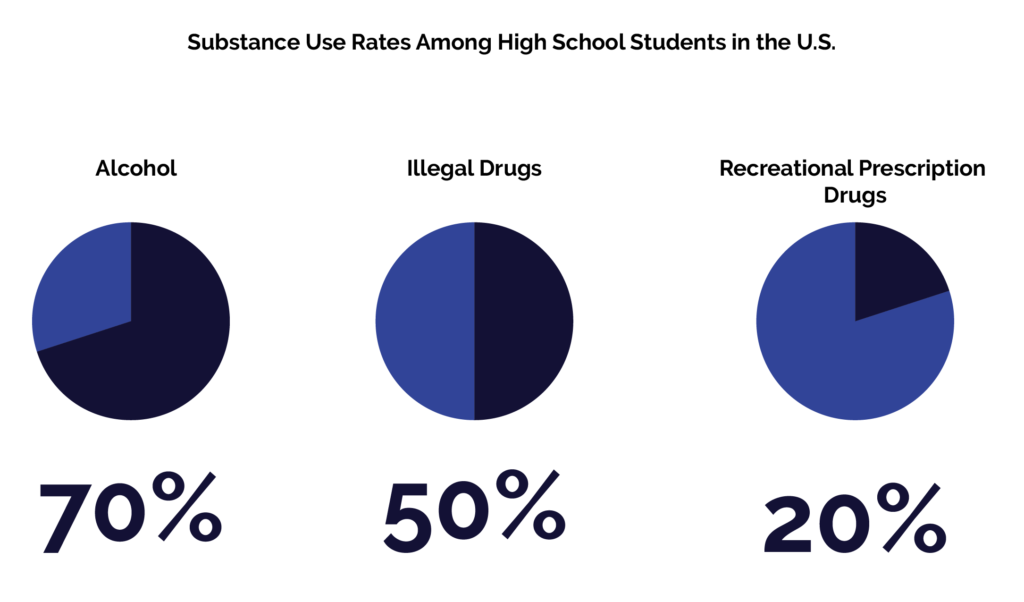
There are countless reasons why adolescents are drawn to alcohol and drugs. Some of the most common reasons for trying substances are as follows:
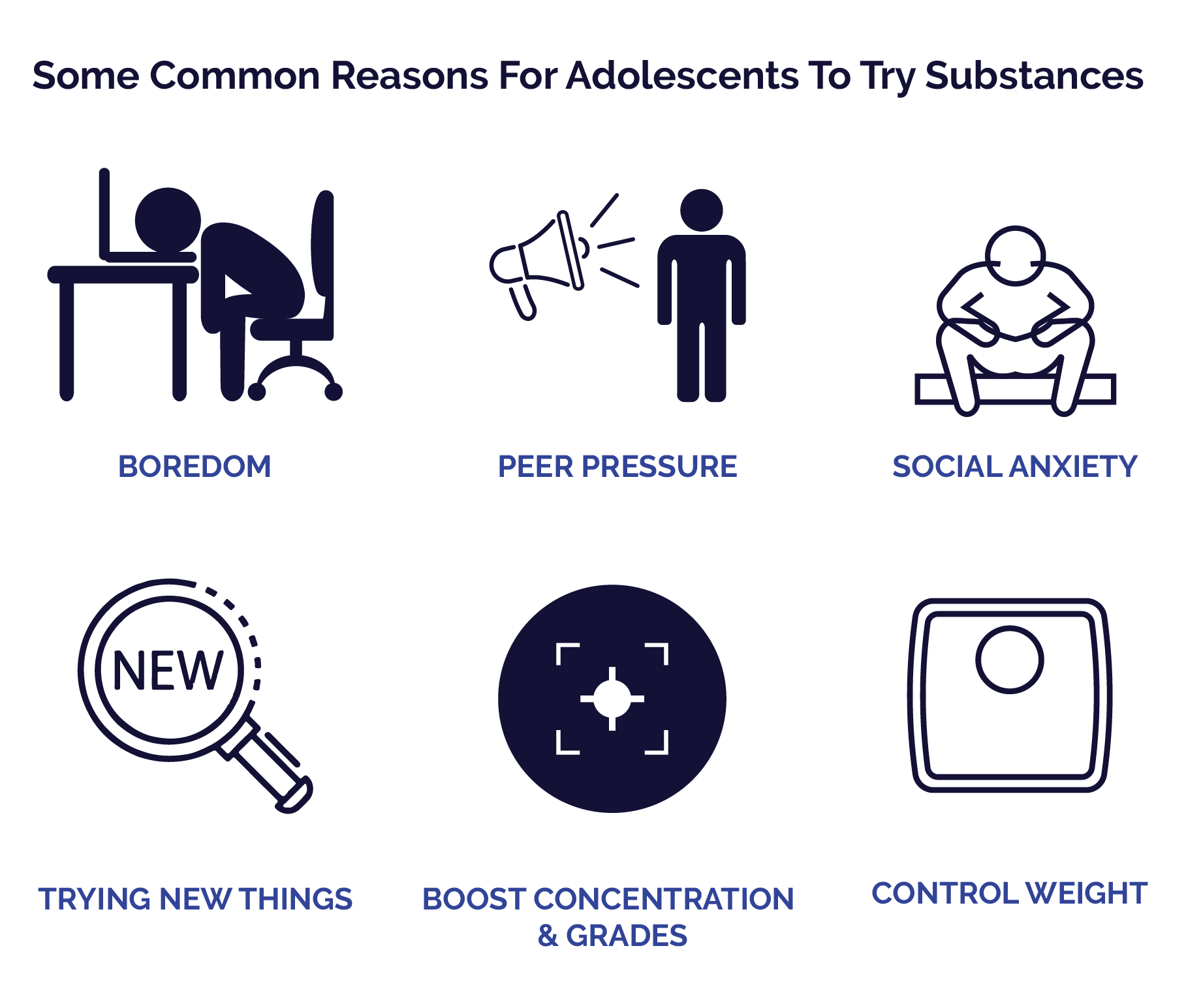
- General boredom
- Peer pressure
- Alleviating social anxiety
- A desire for new experiences
- To improve concentration and boost grades
- To control their weight
- Poor impulse control or a need for excitement
- To escape violence; physical, or emotional abuse at home
- To self-medicate undiagnosed or untreated mental health conditions
Occasionally experimenting with drugs and/or alcohol may fulfill normal developmental teenage drives. After all, teens are biologically hardwired to take risks and act recklessly at times. But given the fact that the adolescent brain does not fully mature until the age of 25, judgment and decision-making skills during this time are limited. As such, repeated drug use during these formative years can have serious long-lasting effects.
Risk and Protective Factors for Adolescent Substance Abuse
Just as there are some common reasons, such as boredom or peer pressure, that can lead adolescents to try drugs, there are risk and protective factors that determine whether a teen will abuse drugs or abstain from abuse. These factors have been explored in the research.
A recent study in the Journal of Addiction found that the following factors increase the risk that a teenager will abuse substances:
While the above factors can increase the risk of substance abuse among teenagers, the following can actually reduce a teen’s risk of becoming involved with drugs or alcohol:
To reduce the risk of teen drug and alcohol abuse while preventing some of the consequences as well, it is important to try to eliminate risk factors and increase protective factors. For example, children who have been victims of abuse, neglect, or assault should be referred to counseling to address these issues. It is also vital to involve teens in positive activities, such as youth groups, sports, community service programs, and clubs, where drug and alcohol use is frowned upon. As a parent, it is critical to establish a strong connection with your teens and praise them for good behavior, such as strong school attendance and participation in positive activities.
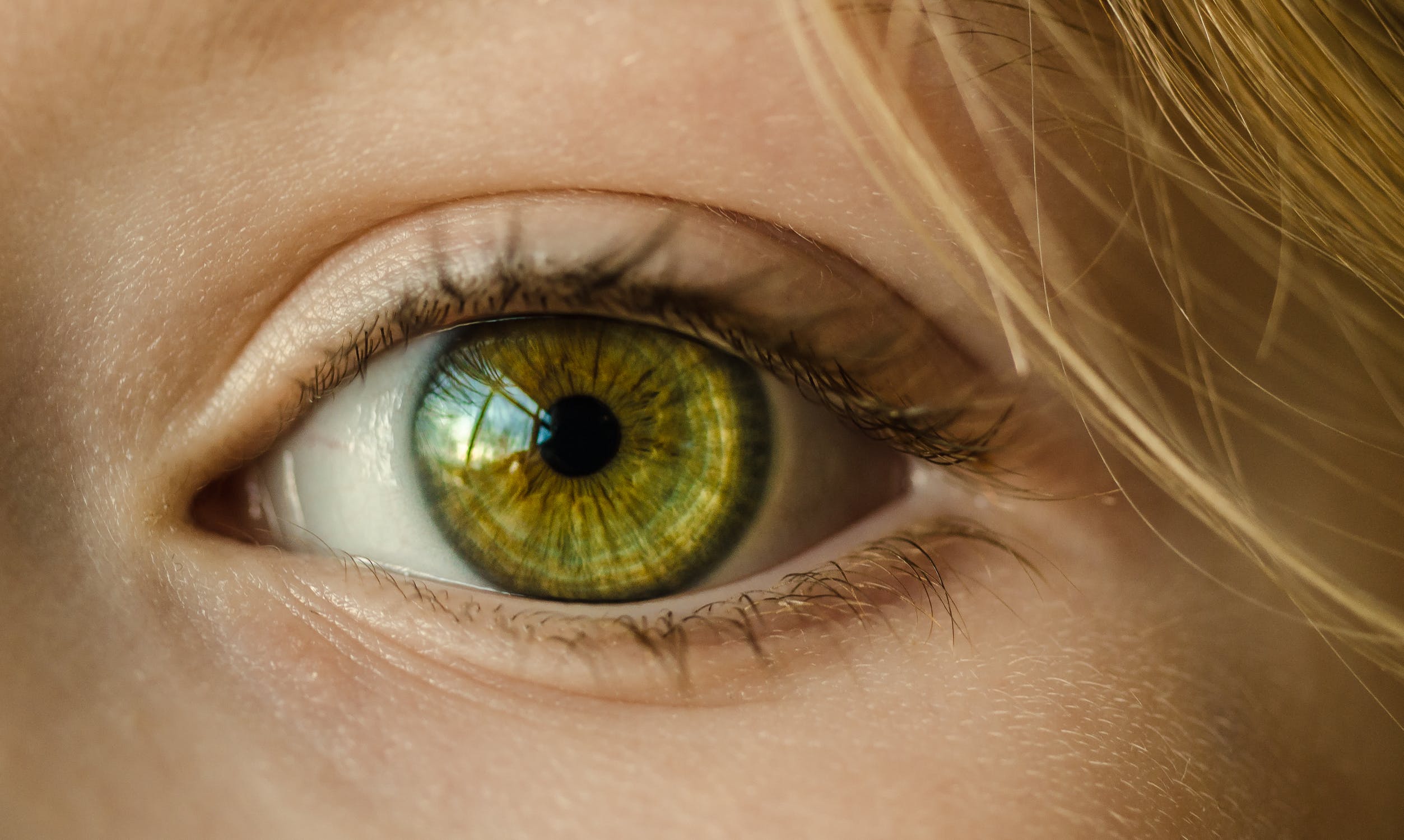
Gateway Drugs: Myth or Fact
Another consideration among adolescents is the fear that some substances can be “gateway drugs,” leading to the abuse of harder drugs like heroin or cocaine. There is some truth to this theory, especially for teens who begin using drugs early. In fact, a 2015 study in the Journal of School Health found that youth may begin using alcohol as early as sixth grade, and those who begin drinking this early are much more likely to progress to using illegal drugs. The study also found that alcohol is the most common substance of abuse among 12th-grade students.
A second study found that teens who used drugs were likely to begin with marijuana or inhalants, leading to using other drugs over time. While not every teen who begins using alcohol, marijuana, or inhalants will progress to using drugs like heroin or cocaine, it is important to recognize the risks of these substances and intervene with teens. Parents may think, “It’s only alcohol,” but for some teens, alcohol use can be a warning sign of more serious problems down the road.
The human brain is made up of billions upon billions of nerve cells called neurons. These groups of neurons send and receive messages which ultimately guide everything we do: from movement and emotion to motivation and feelings of pleasure.
The National Institute on Drug Abuse explains that drugs interfere with the way neurons send and receive messages –– specifically when it comes to levels of dopamine in the brain. At normal levels, dopamine rewards natural behaviors. When drugs are involved, however, the reward system becomes overstimulated. As a result, the brain winds up sending too many “feel-good” signals that cause dopamine levels to surge well above the normal level. When this happens, intense feelings of euphoria take over, teaching the brain that the body needs more and more of the substance to feel the same high as before.
Teenage years are often accompanied by seemingly erratic behaviors, thoughts, and feelings. You might notice that your daughter has suddenly become obsessed with how she does her makeup or the clothing she wears to school. Or maybe your son has been pushing boundaries, acting a little more rebellious and defiant than normal. While discouraging or disheartening to witness, in most cases, these are perfectly normal ways for teenagers to grow and learn. However, there are certain behaviors and actions that point to something far more troubling than your typical coming-of-age emotional turmoil.
If you suspect that your teenager is engaging in alcohol and/or drug use, the following are the most common warning signs to look for:
- Frequent mood swings defined by extreme highs and lows
- Changes in sleeping habits
- Sudden or dramatic weight loss or weight gain
- Declining academic performance
- Lack of respect for authority
- Changing friends or social circles
- Newfound demand for privacy
- Lack of coordination, poor balance, clumsy stumbling
- Flushed skin, bloodshot eyes, and slurred speech
- Slowed breathing or a tendency of nodding off
- Nosebleeds or a runny nose without a cold
- Unexplained bruises, wounds, or marks on their skin
- Acting isolated, silent, or withdrawn
- Becoming uncooperative, defiant, or hostile
- Disinterest in sports, hobbies, or extracurricular activities they previously enjoyed
- Fearfulness or paranoia
- The disappearance of money or valuables
- Unexplained need for more money
- Possession of drug paraphernalia such as pipes, bongs, rolling papers, makeshift smoking devices, aluminum foil, spoons, cotton balls, and short plastic straws
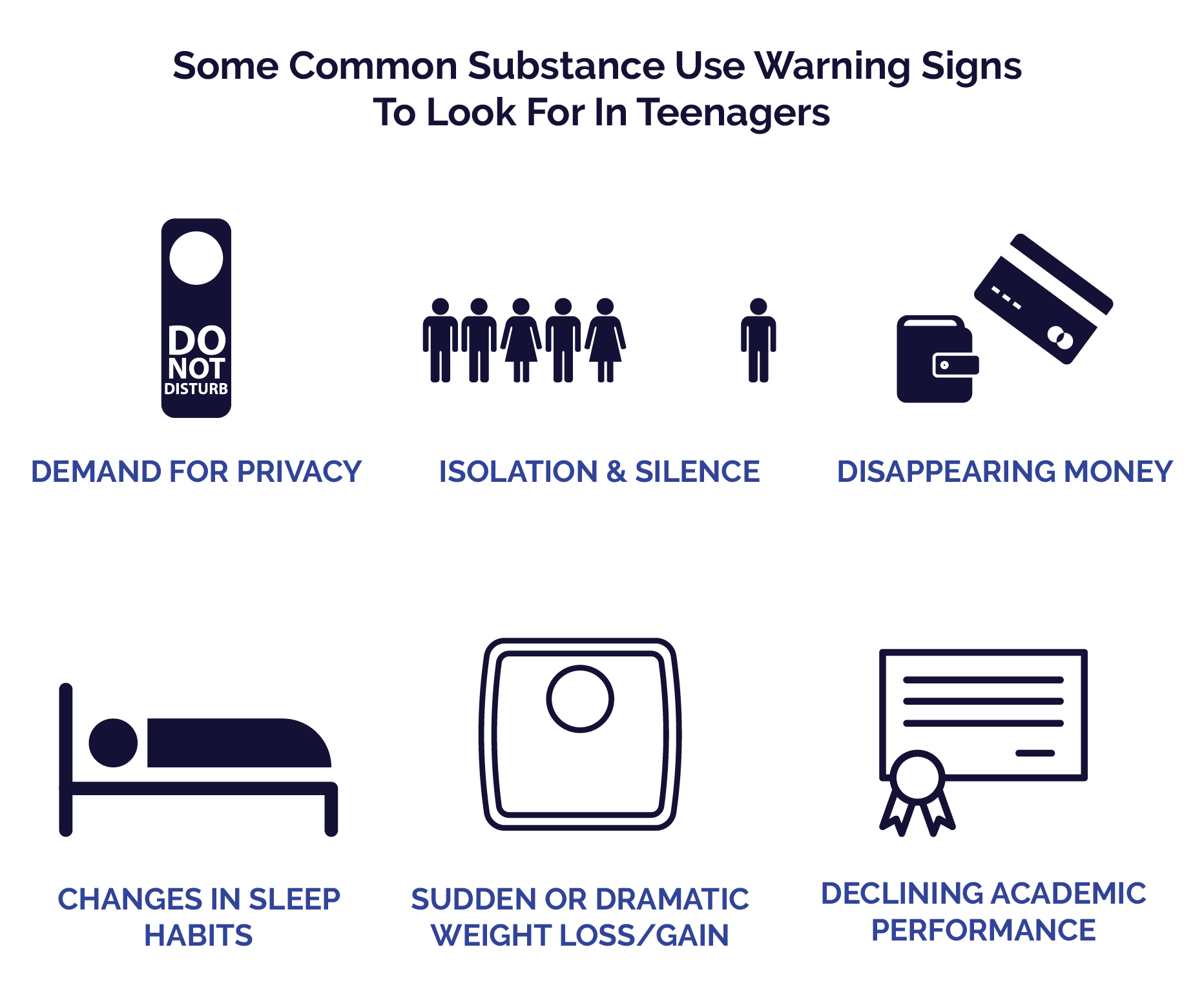
Many of the substances that teenagers experiment with have been around for many years, and then there are new trends that burst onto the scene rapidly. From bath salts and spice to flakka, kratom, and krokodil, there are countless varieties of substances that have emerged that have caused immense concern among parents.
In Santa Barbara and Ventura, however, the following are the most common trends among adolescents.
Alcohol
Alcohol is the drug of choice among many adolescents. In fact, the CDC reports that it is the most commonly used and abused drug among youth in the United States. Unsurprisingly, it also has the ability to cause detrimental damage — every year, nearly 200,000 ER visits and 4,300 deaths are attributed to underage drinking.
The scariest part of adolescent drinking is that it can escalate into alcohol dependence later in life. Youth who start drinking before age 15 are six times more likely to develop a substance use disorder than those who begin drinking at or after age 21 years.
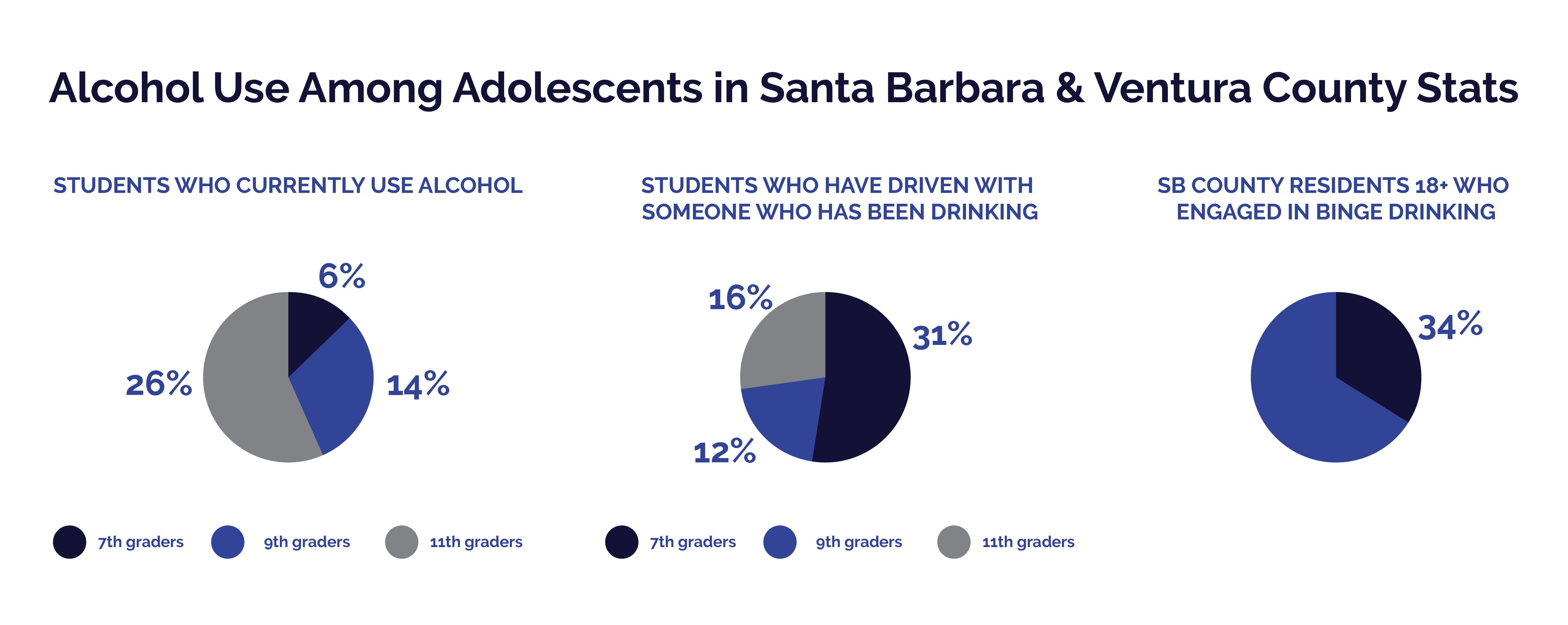
- Statistics about underage drinking & binge drinking in Santa Barbara and Ventura County:
- In Ventura County, 6% of 7th graders, 14% of 9th graders, and 26% of 11th graders currently use alcohol.
- 31% of 7th graders, 12% of 9th graders, and 16% of 11th graders in Ventura County have ridden in a car driven by someone who had been drinking alcohol.
- Approximately 34% of Santa Barbara County residents age 18 and older participated in binge drinking compared to the statewide rate of 30 percent.
Marijuana
While alcohol and illicit drug use rates have seen somewhat of a decline amongst adolescents in recent years, marijuana is a notable exception to this trend. Marijuana legalization in California could be to blame for its rise in popularity among adolescent students: 37.1% of high school seniors, 25.5% of high school sophomores, and 10.1% of eighth graders admitted to using the drug at least once in the last year. Recreational cannabis sales could also be a contributing factor in teen’s opinions of its long-term impact. Among eighth-graders, there was a 14% drop in “perception of harmfulness”, and a 16% decrease among 10th-graders. In comparison to states where recreational marijuana use has not been legalized, perceptions of damage or harm decreased at rates of 5% to 7%.
Many people view marijuana as a “natural herb” and therefore consider it to be harmless. However, studies have shown that prolonged use of cannabis has been linked to a range of developmental and social problems, including cognitive and memory problems and declining IQ.
Prescription Drugs
The fastest-growing drug problem in the United States is hiding in plain sight –– in your home, nonetheless. According to data, an estimated 2.1 million Americans used prescription drugs non-medically for the first time within the past year; of that group, 54% were females and nearly 30% were adolescents. Many teens foolishly believe that prescription drugs are safe to use because they’ve been prescribed by a doctor; however, when not used as medically directed, they can have dangerous consequences.
In Santa Barbara and the Tri-County region, research indicates that prescription drug abuse has continued to be a growing problem.
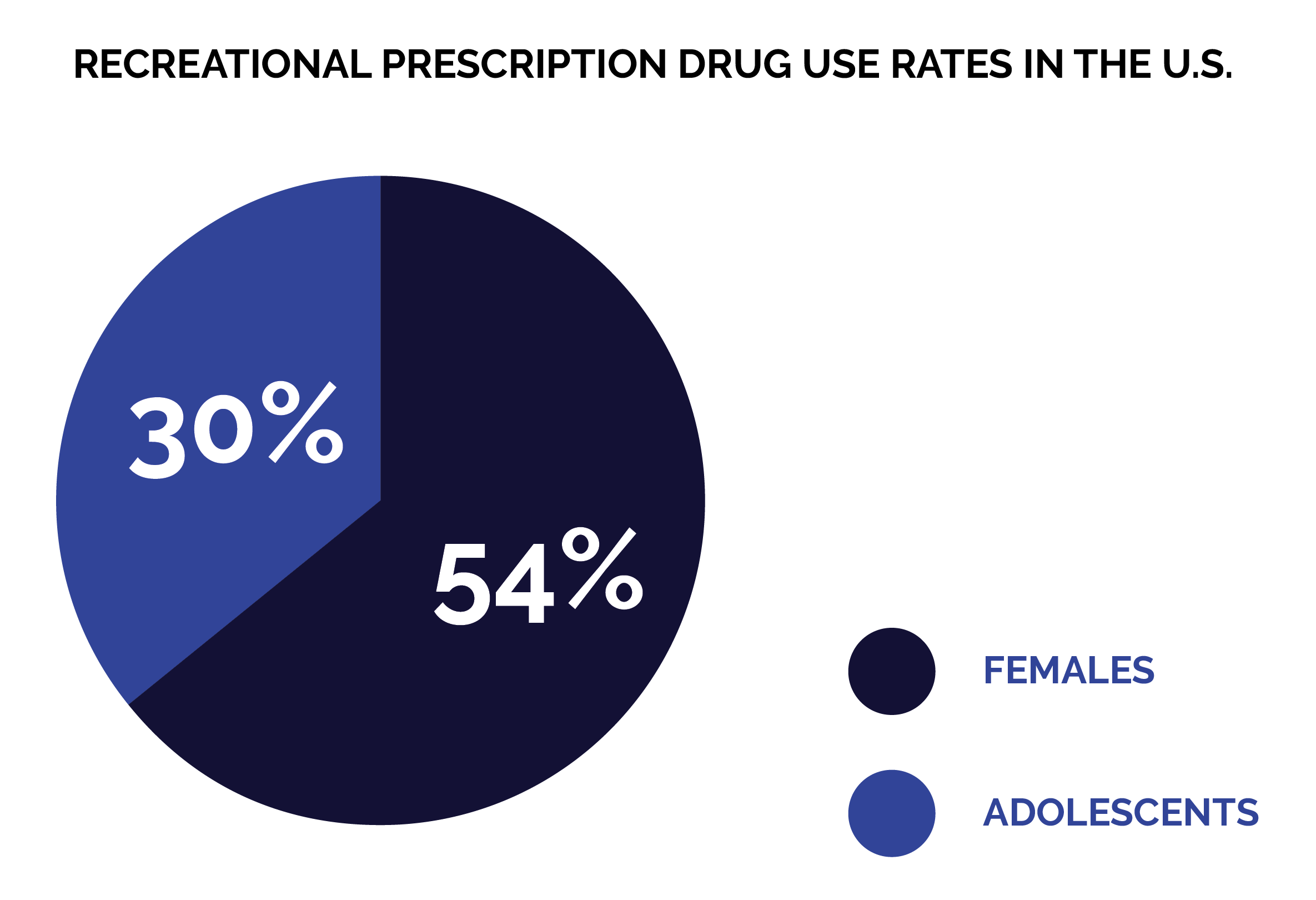
Some of the most commonly abused prescription drugs among adolescents in these areas include:
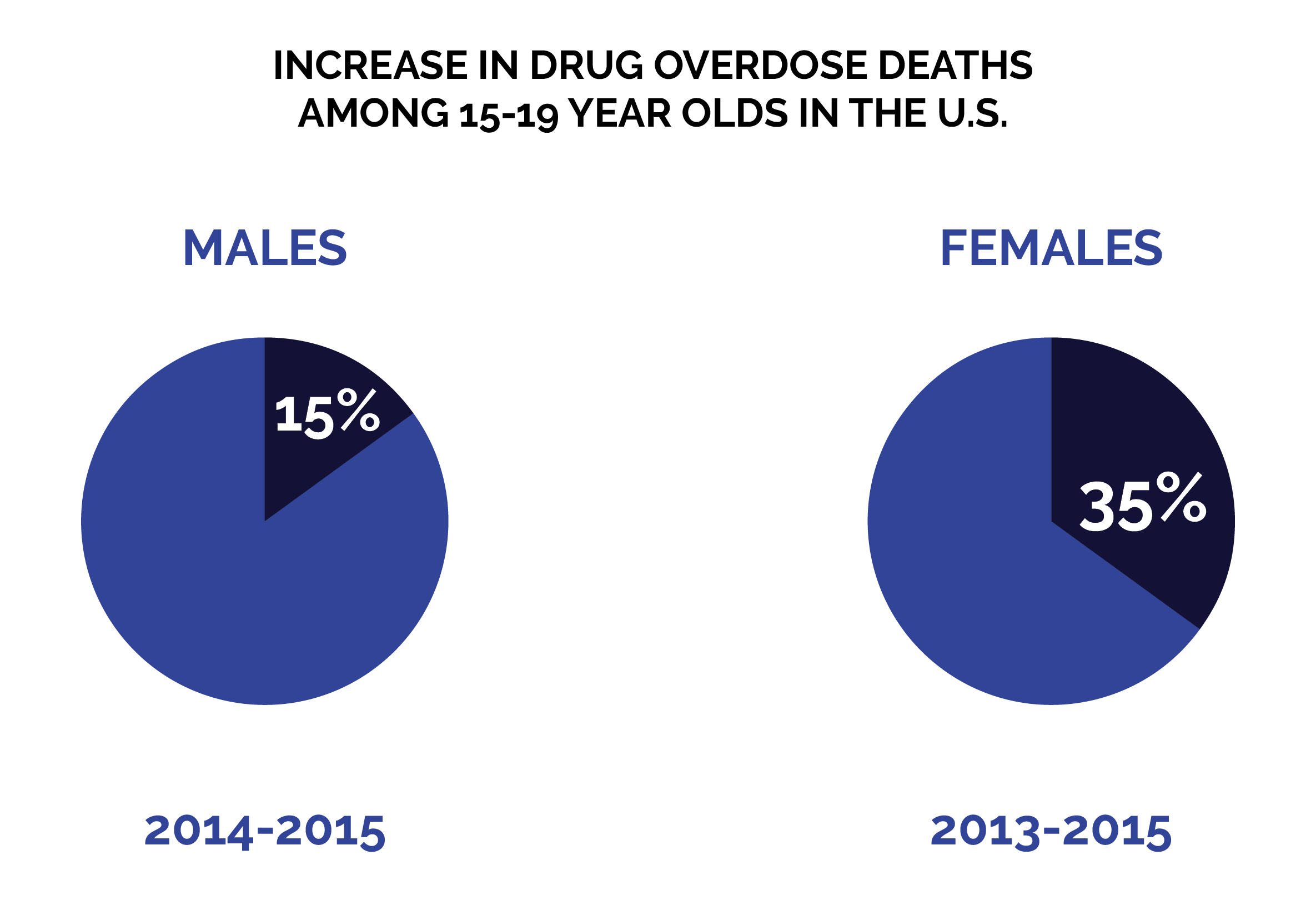
Opioids
- More and more teens are accidentally and fatally overdosing due to misuse of opioids. The CDC found that the total number of drug overdose deaths among 15 to 19-year-olds rose 15% for males from 2014 to 2015 and 35% for females from 2013 to 2015.
-
- Common drug names include:
- OxyContin
- Vicodin
- Morphine
- Fentanyl
- Codeine
- Tramadol
- Common drug names include:
-
Stimulants
- In recent years, the misuse of prescription stimulants –– aka, “study drugs” –– has become an increasing problem among American adolescents. Santa Barbara County survey data found that 3% of 11th graders and 2% of 9th graders are using these types of drugs four or more times.
- Common drug names include:
- Adderall
- Ritalin
- Common drug names include:
Tranquilizers/Sedatives
- Prescription depressants, which are typically used to treat anxiety, panic attacks, and sleep disorders, are used to slow down the normal activity that goes on in the brain and spinal cord. The MTF study found that 6.9% of 12th graders and 5.8% of 10th graders have abused tranquilizers in their lifetime.
- Common drug names include:
- Xanax
- Klonopin
- Valium
- Common drug names include:
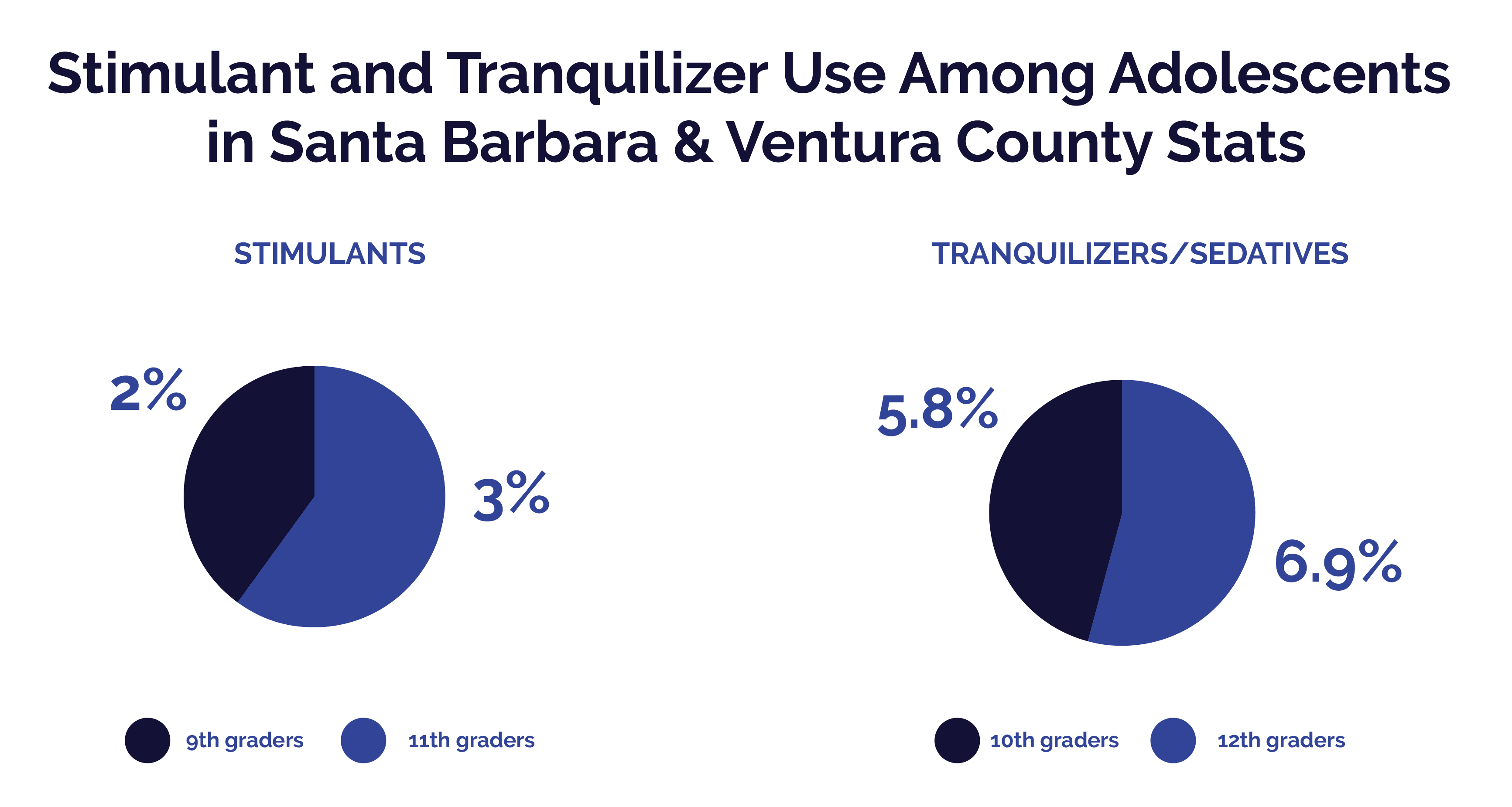
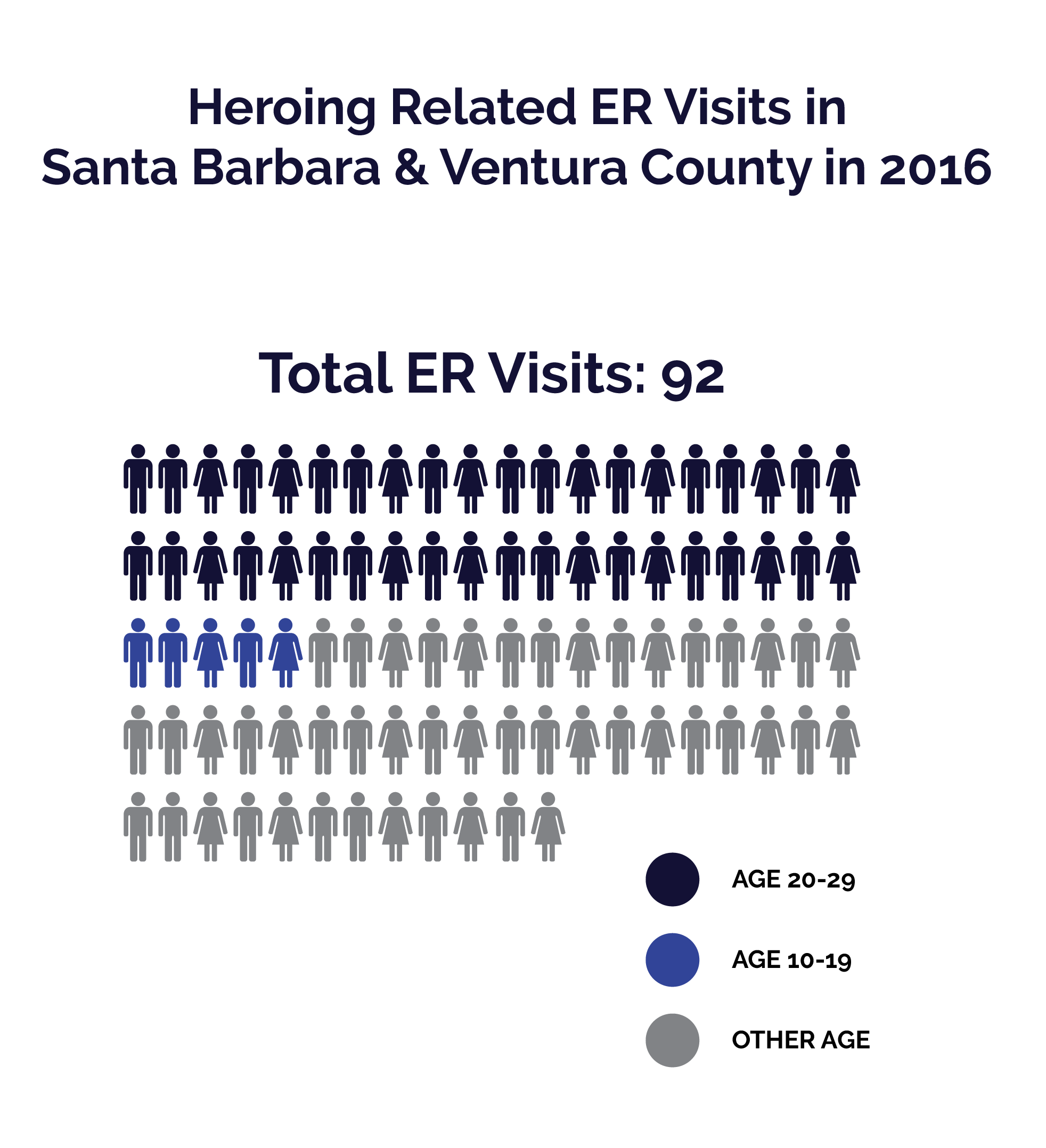
Heroin
One of the unintended consequences of America’s growing prescription drug epidemic has been the increase in heroin addiction and overdoses. This is because many people will resort to heroin when they can no longer obtain prescription opioids, either by prescription from a doctor or via a friend or family member (either free or stolen).
- Statistics about heroin abuse in Santa Barbara and Ventura County:
- Of the 92 heroin poisoning visits to the emergency room in 2016, more than 40 patients were residents between the ages of 20 to 29, and five were between the ages of 10 to 19.
- From January to May 2016, five heroin-related ER trips involved people ages 10-19 –– a 66% increase from the previous year.
Given that adolescence is often defined by immaturity, risky behaviors, and feelings of invincibility, it’s no wonder that many teens are unaware of the consequences of substance use. The truth of the matter is that a number of both physical and mental health issues can arise when an individual repeatedly abuses alcohol and/or drugs.
Some of the long-term physical effects of repeated substance use include:
- Heart, liver, and kidney diseases
- Cardiovascular problems (e.g., collapsed veins, bacterial blood infections)
- Damage to the respiratory system (e.g., infections and tissue death of the nasal linings and sinuses, pulmonary edema, pulmonary hemorrhage)
- A weakening of the immune system
- Reduced sexual capacity and long-term impotence in men
- Adverse changes in brain chemistry
- Hepatitis, HIV/AIDS, and other infectious diseases
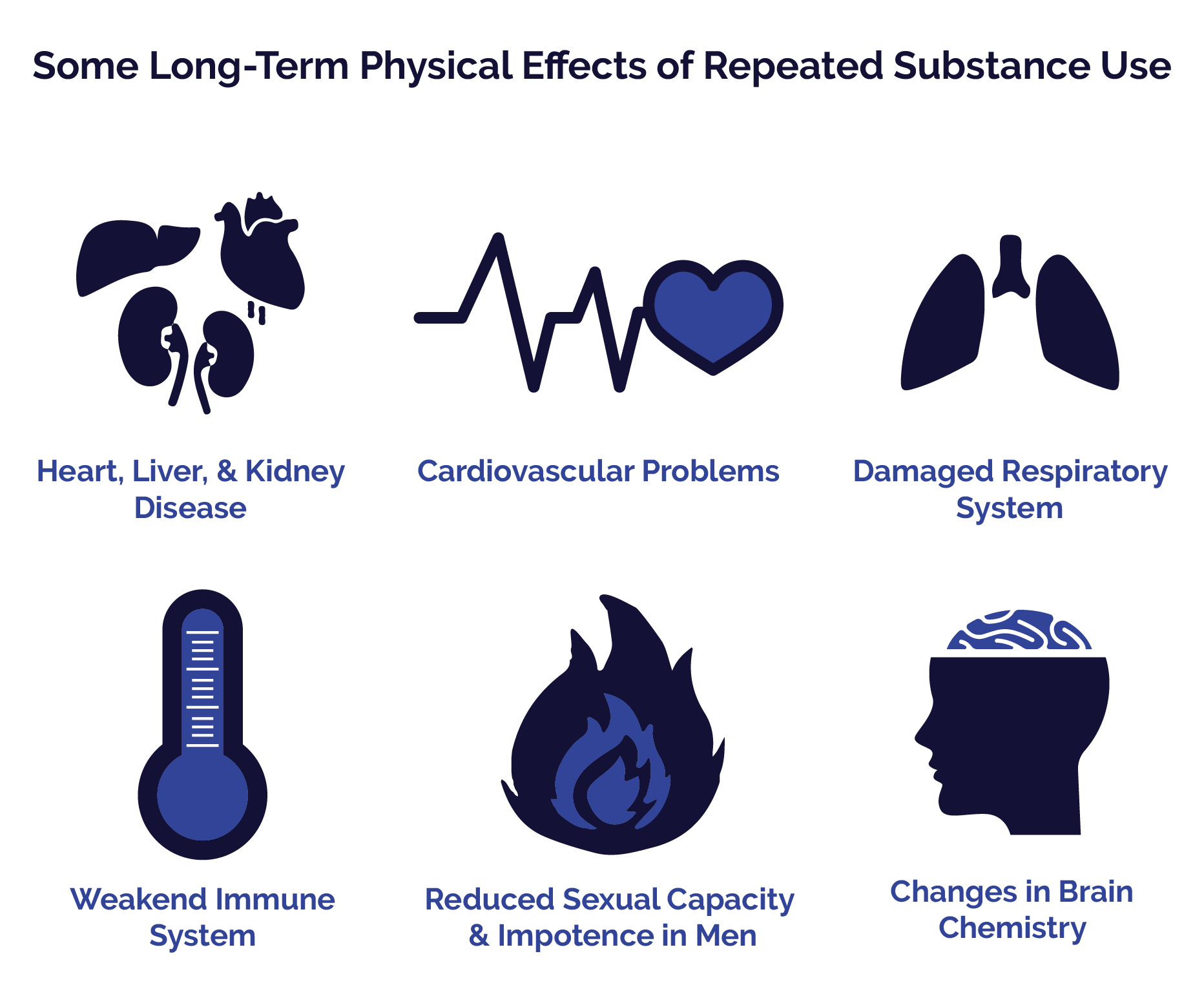
The long-term psychological and behavioral effects of repeated substance use include:
- Exorbitantly spending beyond one’s means and going into debt
- Inability to maintain a steady job
- Frequent legal troubles such as domestic violence, driving under the influence, robbery, theft, and burglary
- Unstable romantic relationships
- Child neglect (prenatal and/or during the child’s upbringing)
- Increased risk of mental health disorders such as depression, anxiety, and psychosis
Parents who are highly involved in their children’s lives have a greater chance of noticing early warning signs of a drug and/or alcohol problem. The fortunate thing is that substance use disorders are far more likely to be treated if the problem is identified and addressed in adolescence.
Some of the following tips can help to ensure that your child stays away from alcohol and drug abuse:
- Communication is key! Have frequent conversations with them, and make sure you listen to them.
- Don’t be in denial. Find out if addiction runs in your family, and be sure to keep an open dialogue with your son or daughter about the risks.
- Promote healthy activities to help fight off boredom and improve mental stimulation.
- Establish clear family rules about drug and alcohol use and consistently enforce them.
- Keep track of the alcohol and/or prescription drugs that you keep in the house.
- Remain calm in stressful situations and always treat them with respect.
- Always come from a place of love, understanding, and compassion.
- Enhance your own personal growth by taking part in activities and hobbies outside of the home.
- Be proactive. If you feel like something is fishy, check for evidence of alcohol and/or drug use.
- Stay up to date on prevention education. The more you know, the better prepared you can be.
Treatment Needs of Adolescents
Given the risks of drug abuse among teens and the effects of addiction on the teenage brain, effective treatment is essential. Experts agree that treatment should include thorough assessment to ensure that all of a teen’s issues are addressed and comprehensive services that can treat other problems, such as medical issues, mental illness, academic concerns, and family issues that occur alongside addiction.
Other components of successful addiction treatment for adolescents include involvement of the family, experienced staff, aftercare programming, and staff who can convince adolescents of the importance of treatment.
If you are seeking addiction treatment for a teenager and are in the Santa Barbara or Southern California area, Mission Harbor Behavioral Health offers a program specifically for adolescents. Our clinical staff who manage the program have over 20 years of experience, and our program includes the family. We offer weekly family therapy sessions as well as parent support groups. Contact us today to learn how our experienced team can help your family to recover from the effects of teen substance abuse.
Updated content on 4/21/21
This guide is intended to be informational. If you are considering help for you or your loved one and would like more information, please consult a medical professional or licensed treatment facility.

